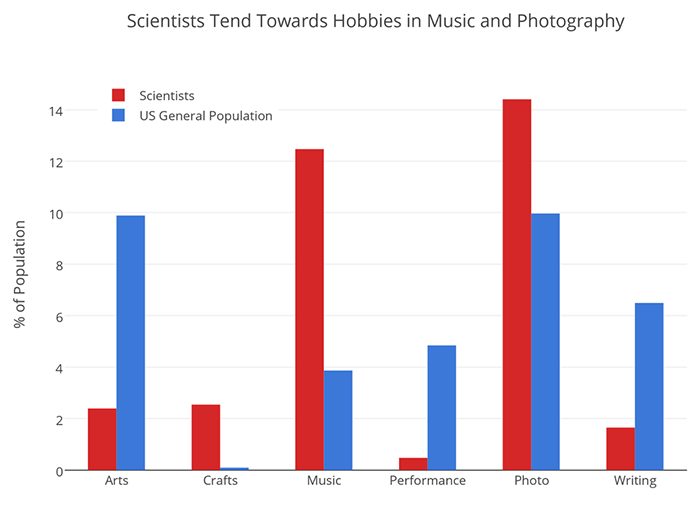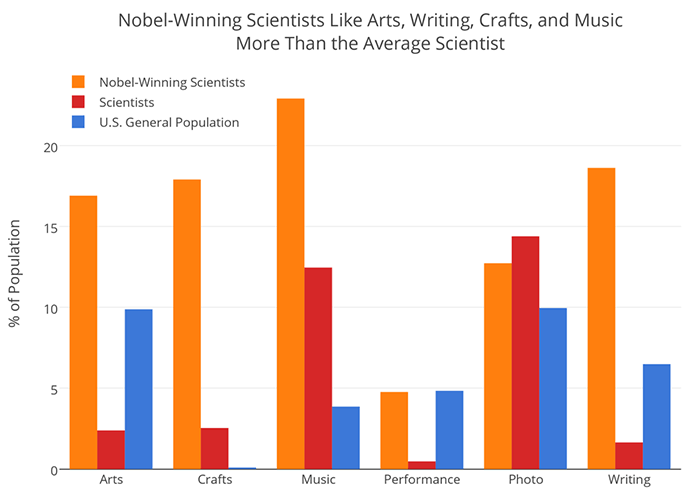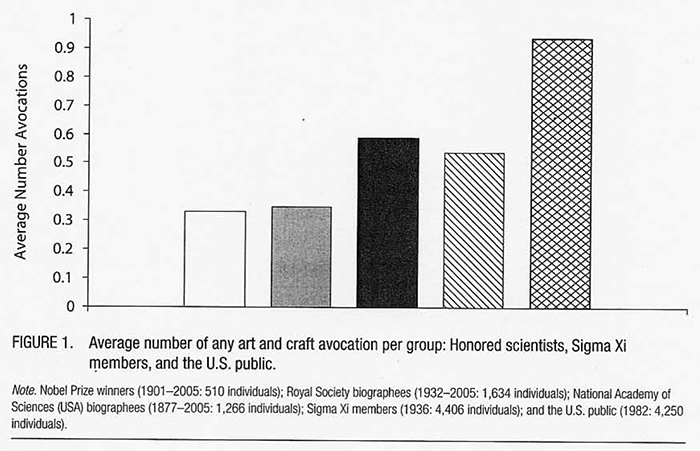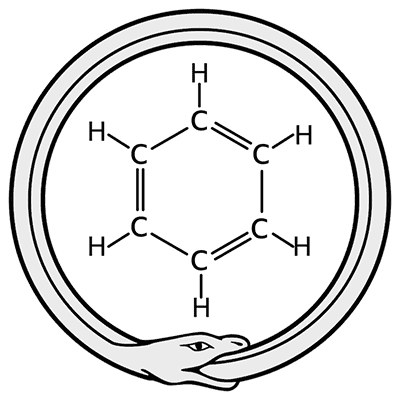How do scientists differ from ordinary people, except intelligence
It is clear that scientists are superior to average citizens in intelligence. But another question is interesting: how does this intelligence manifest, that is, in what other aspects of life do intelligent people differ from stupid? The study ( pdf ), conducted at the University of Michigan, allows us to draw some conclusions.
The purpose of the study was to compare the usual audience of the US population with scientists (members of the Sigma Xi society). In turn, ordinary scientists were compared with members of the National Academy of Sciences, that is, with prominent representatives of science, and with Nobel laureates, who can be considered geniuses.
The authors of the study traced how attitudes towards crafts and “humanitarian” hobbies change: with increased intelligence: manual labor, hobbies, drawing, literary activities, photography, writing music, theatrical performances, etc.
Sigma Xi is a professional society where any scientist or engineer has the right to join. Hobbies and hobbies were determined by personal data.
')
Information about the hobbies and hobbies of prominent representatives of science and Nobel laureates were taken from autobiographies and articles about them. Only such cases were counted when the text explicitly stated that the scientist was engaged in a specific type of activity. For example, what plays on a particular musical instrument. Phrases like “big music lover” were not considered.
So, with a certain degree of conditionality, we have a series: an ordinary person - an ordinary scientist - an outstanding scientist - a genius. In this row, the average intelligence of the sample rises at each stage. What changes else?
First, here is a diagram that shows how scientists differ from the average mass of the population. The percentage indicates how many representatives of this sample are keen on art, craft, music, performances before the public (perfomance), photography, literary activities.

The difference is quite serious. Scientists are three times more likely to play music than ordinary people. They are a little more interested in photography. The most characteristic hobby of scientists, which sharply distinguishes them from ordinary people, is manual labor as a hobby, craftsmanship, making all kinds of crafts. Here, intellectuals are an order of magnitude superior to ordinary people.
There are several areas that people with higher intelligence do less than the general public. This is art (drawing pictures, etc.), literary activity (writing poetry, etc.) and, especially, speaking in public. For some reason, ordinary scientists absolutely do not like to go on stage as actors, although a lot of average people like it.
However, if you add a sample of Nobel laureates, the picture changes dramatically. It turns out that genius people sharply increase their inclination to almost all types of non-core activities, including the same literary activity, speaking in public, drawing pictures, and so on. In this sense, brilliant people are uniquely versatile personalities who take a great interest in literally everyone. Every fourth Nobel Prize winner plays the musical instrument!

If all the areas of arts and hobbies are fully averaged, then a paradoxical picture emerges. The average scientist is almost the same as an ordinary person. But the more talented a person is, the more often a foreign hobby is manifested.

Such studies are conducted not for the sake of idle curiosity, but in order to increase the effectiveness of scientific activity. For example, experts in cognitive sciences recently prepared a report entitled “The Two-Way Process of Thinking for Scientists” (“Dual thinking for scientists”), where they are trying to formulate the meaning of the so-called left and right hemispheres in scientific activities. In their terminology, for physiological reasons, each person’s thinking occurs in two ways: the “fast” uncontrollable and unrecognizable “first system” is responsible for intuition, and the slow “second system” of conscious thinking is responsible for reasoning and logic. According to experts, scientists are accustomed to constantly use only the second system. At the same time, the first system can help a lot.
In other words, with the help of associative thinking, intuitive actions that are illogical at first sight, it is sometimes possible to make an important scientific discovery and find a creative solution to a scientific problem. There are many examples in the history of science that prove this.
An illustrative story happened to the German chemist Friedrich August Kekule, who for a long time could not understand the structure of the benzene molecule with the “wild” formula C 6 H 6 . One day he fell asleep in an armchair in front of the fireplace - and he dreamed of a snake biting its tail. The scientist woke up with the brilliant idea that the benzene molecule is coiled into a ring! Previously, no one could guess this.

To improve the efficiency of work, experts recommend scientists and people of creative mental work to practice actions that look like procrastination from the outside. For example, aimless walks (preferably without planning a route in advance), hobbies, taking a bath, excess sleep, and so on.
The purpose of the study was to compare the usual audience of the US population with scientists (members of the Sigma Xi society). In turn, ordinary scientists were compared with members of the National Academy of Sciences, that is, with prominent representatives of science, and with Nobel laureates, who can be considered geniuses.
The authors of the study traced how attitudes towards crafts and “humanitarian” hobbies change: with increased intelligence: manual labor, hobbies, drawing, literary activities, photography, writing music, theatrical performances, etc.
Sigma Xi is a professional society where any scientist or engineer has the right to join. Hobbies and hobbies were determined by personal data.
')
Information about the hobbies and hobbies of prominent representatives of science and Nobel laureates were taken from autobiographies and articles about them. Only such cases were counted when the text explicitly stated that the scientist was engaged in a specific type of activity. For example, what plays on a particular musical instrument. Phrases like “big music lover” were not considered.
So, with a certain degree of conditionality, we have a series: an ordinary person - an ordinary scientist - an outstanding scientist - a genius. In this row, the average intelligence of the sample rises at each stage. What changes else?
First, here is a diagram that shows how scientists differ from the average mass of the population. The percentage indicates how many representatives of this sample are keen on art, craft, music, performances before the public (perfomance), photography, literary activities.

The difference is quite serious. Scientists are three times more likely to play music than ordinary people. They are a little more interested in photography. The most characteristic hobby of scientists, which sharply distinguishes them from ordinary people, is manual labor as a hobby, craftsmanship, making all kinds of crafts. Here, intellectuals are an order of magnitude superior to ordinary people.
There are several areas that people with higher intelligence do less than the general public. This is art (drawing pictures, etc.), literary activity (writing poetry, etc.) and, especially, speaking in public. For some reason, ordinary scientists absolutely do not like to go on stage as actors, although a lot of average people like it.
However, if you add a sample of Nobel laureates, the picture changes dramatically. It turns out that genius people sharply increase their inclination to almost all types of non-core activities, including the same literary activity, speaking in public, drawing pictures, and so on. In this sense, brilliant people are uniquely versatile personalities who take a great interest in literally everyone. Every fourth Nobel Prize winner plays the musical instrument!

If all the areas of arts and hobbies are fully averaged, then a paradoxical picture emerges. The average scientist is almost the same as an ordinary person. But the more talented a person is, the more often a foreign hobby is manifested.

Such studies are conducted not for the sake of idle curiosity, but in order to increase the effectiveness of scientific activity. For example, experts in cognitive sciences recently prepared a report entitled “The Two-Way Process of Thinking for Scientists” (“Dual thinking for scientists”), where they are trying to formulate the meaning of the so-called left and right hemispheres in scientific activities. In their terminology, for physiological reasons, each person’s thinking occurs in two ways: the “fast” uncontrollable and unrecognizable “first system” is responsible for intuition, and the slow “second system” of conscious thinking is responsible for reasoning and logic. According to experts, scientists are accustomed to constantly use only the second system. At the same time, the first system can help a lot.
In other words, with the help of associative thinking, intuitive actions that are illogical at first sight, it is sometimes possible to make an important scientific discovery and find a creative solution to a scientific problem. There are many examples in the history of science that prove this.
An illustrative story happened to the German chemist Friedrich August Kekule, who for a long time could not understand the structure of the benzene molecule with the “wild” formula C 6 H 6 . One day he fell asleep in an armchair in front of the fireplace - and he dreamed of a snake biting its tail. The scientist woke up with the brilliant idea that the benzene molecule is coiled into a ring! Previously, no one could guess this.

To improve the efficiency of work, experts recommend scientists and people of creative mental work to practice actions that look like procrastination from the outside. For example, aimless walks (preferably without planning a route in advance), hobbies, taking a bath, excess sleep, and so on.
Source: https://habr.com/ru/post/368239/
All Articles